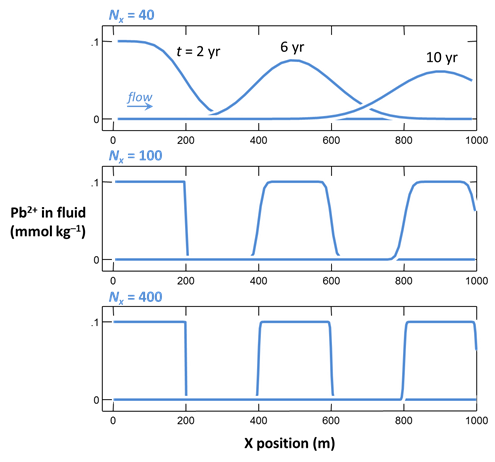Numerical dispersion
Numerical Dispersion is part of a free web series, GWB Online Academy, by Aqueous Solutions LLC.
What you need:
- GWB Professional recommended
-
Input file:
 Pulse.x1t
Pulse.x1t
Download this unit to use in your courses:
- Lesson plan (.pdf)
- PowerPoint slides (.pptx)
Click on a file or right-click and select “Save link as…” to download.
Introduction
Von Neumann's criterion tells us the maximum time step our numerical solver can take to yield a stable solution to a pure diffusive transport problem

The Courant condition

accounts for advective transport. It states that fluid cannot travel farther than the length of a nodal block within a single time step. Taken together, the stability criterion in one dimension is show below

The Grid Courant number

is the number of nodal blocks traversed by the fluid over the course of a time step.
This number is reported on the Results pane

Numerical dispersion is a special class of truncation error that appears when solving the diffusion-advection equation by finite differences. The phenomenon adds an artificial dispersion to the solution

so that in effect we are solving

Where numerical dispersion is small relative to physical dispersion, this may not be a huge deal. On the other hand, if numerical dispersion is very large, then we are introducing error, which is undesirable.
Task 1: Effect of numerical dispersion
Open "Pulse.x1t", the example we looked at in our Mass Transport lesson, and on the Medium pane, set αL to “0”

to eliminate physical dispersion from the model. On Config → Output… set a suffix "_num400"

and select Run → Go.
Now, redo the calculation using fewer nodal blocks. On the Domain pane set Nx to 100

and specify a new suffix "_num100". Run the model, then repeat using 40 nodal blocks: Nx = 40 and suffix "_num40".
How do the simulation results vary, depending on your choice of nodal block spacing?
How might we minimize numerical dispersion? Remember, we can quantify a coefficient of numerical dispersion as shown below:

A good strategy is to start working with a simple model, then add complexity as it is needed. After running a model with a course grid, cut the length of nodal blocks in half and see whether the solution changes. Once you reach the point where you can't observe any change between subsequent runs, you've likely minimized numerical dispersion as much as you can.
Authors
Craig M. Bethke and Brian Farrell. © Copyright 2016–2025 Aqueous Solutions LLC. This lesson may be reproduced and modified freely to support any licensed use of The Geochemist's Workbench® software, provided that any derived materials acknowledge original authorship.
References
Bethke, C.M., 2022, Geochemical and Biogeochemical Reaction Modeling, 3rd ed. Cambridge University Press, New York, 520 pp.
Bethke, C.M., B. Farrell, and M. Sharifi, 2025, The Geochemist's Workbench®, Release 18: GWB Reactive Transport Modeling Guide. Aqueous Solutions LLC, Champaign, IL, 191 pp.
Comfortable with numerical dispersion?
Move on to the next topic, Dual Porosity, or return to the GWB Online Academy home.
